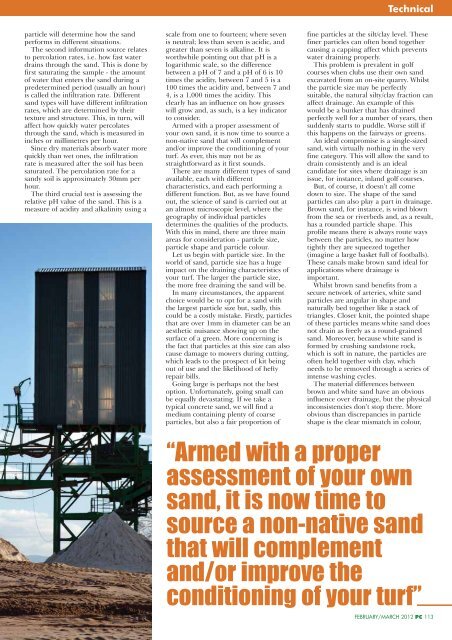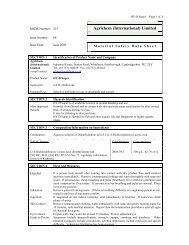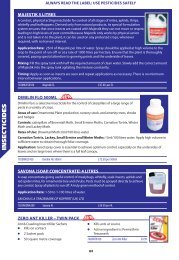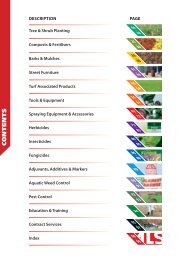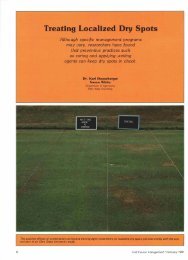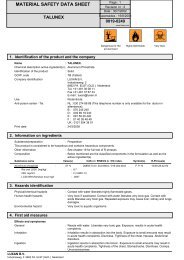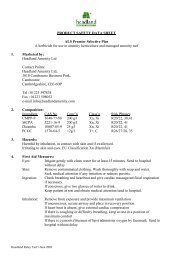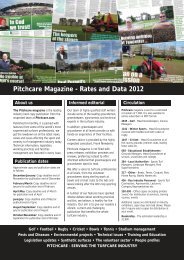these Open Championship Clubs choose to relief grind - Pitchcare
these Open Championship Clubs choose to relief grind - Pitchcare
these Open Championship Clubs choose to relief grind - Pitchcare
Create successful ePaper yourself
Turn your PDF publications into a flip-book with our unique Google optimized e-Paper software.
particle will determine how the sand<br />
performs in different situations.<br />
The second information source relates<br />
<strong>to</strong> percolation rates, i.e. how fast water<br />
drains through the sand. This is done by<br />
first saturating the sample - the amount<br />
of water that enters the sand during a<br />
predetermined period (usually an hour)<br />
is called the infiltration rate. Different<br />
sand types will have different infiltration<br />
rates, which are determined by their<br />
texture and structure. This, in turn, will<br />
affect how quickly water percolates<br />
through the sand, which is measured in<br />
inches or millimetres per hour.<br />
Since dry materials absorb water more<br />
quickly than wet ones, the infiltration<br />
rate is measured after the soil has been<br />
saturated. The percolation rate for a<br />
sandy soil is approximately 30mm per<br />
hour.<br />
The third crucial test is assessing the<br />
relative pH value of the sand. This is a<br />
measure of acidity and alkalinity using a<br />
scale from one <strong>to</strong> fourteen; where seven<br />
is neutral; less than seven is acidic, and<br />
greater than seven is alkaline. It is<br />
worthwhile pointing out that pH is a<br />
logarithmic scale, so the difference<br />
between a pH of 7 and a pH of 6 is 10<br />
times the acidity, between 7 and 5 is a<br />
100 times the acidity and, between 7 and<br />
4, is a 1,000 times the acidity. This<br />
clearly has an influence on how grasses<br />
will grow and, as such, is a key indica<strong>to</strong>r<br />
<strong>to</strong> consider.<br />
Armed with a proper assessment of<br />
your own sand, it is now time <strong>to</strong> source a<br />
non-native sand that will complement<br />
and/or improve the conditioning of your<br />
turf. As ever, this may not be as<br />
straightforward as it first sounds.<br />
There are many different types of sand<br />
available, each with different<br />
characteristics, and each performing a<br />
different function. But, as we have found<br />
out, the science of sand is carried out at<br />
an almost microscopic level, where the<br />
geography of individual particles<br />
determines the qualities of the products.<br />
With this in mind, there are three main<br />
areas for consideration - particle size,<br />
particle shape and particle colour.<br />
Let us begin with particle size. In the<br />
world of sand, particle size has a huge<br />
impact on the draining characteristics of<br />
your turf. The larger the particle size,<br />
the more free draining the sand will be.<br />
In many circumstances, the apparent<br />
choice would be <strong>to</strong> opt for a sand with<br />
the largest particle size but, sadly, this<br />
could be a costly mistake. Firstly, particles<br />
that are over 1mm in diameter can be an<br />
aesthetic nuisance showing up on the<br />
surface of a green. More concerning is<br />
the fact that particles at this size can also<br />
cause damage <strong>to</strong> mowers during cutting,<br />
which leads <strong>to</strong> the prospect of kit being<br />
out of use and the likelihood of hefty<br />
repair bills.<br />
Going large is perhaps not the best<br />
option. Unfortunately, going small can<br />
be equally devastating. If we take a<br />
typical concrete sand, we will find a<br />
medium containing plenty of coarse<br />
particles, but also a fair proportion of<br />
Technical<br />
fine particles at the silt/clay level. These<br />
finer particles can often bond <strong>to</strong>gether<br />
causing a capping affect which prevents<br />
water draining properly.<br />
This problem is prevalent in golf<br />
courses when clubs use their own sand<br />
excavated from an on-site quarry. Whilst<br />
the particle size may be perfectly<br />
suitable, the natural silty/clay fraction can<br />
affect drainage. An example of this<br />
would be a bunker that has drained<br />
perfectly well for a number of years, then<br />
suddenly starts <strong>to</strong> puddle. Worse still if<br />
this happens on the fairways or greens.<br />
An ideal compromise is a single-sized<br />
sand, with virtually nothing in the very<br />
fine category. This will allow the sand <strong>to</strong><br />
drain consistently and is an ideal<br />
candidate for sites where drainage is an<br />
issue, for instance, inland golf courses.<br />
But, of course, it doesn’t all come<br />
down <strong>to</strong> size. The shape of the sand<br />
particles can also play a part in drainage.<br />
Brown sand, for instance, is wind blown<br />
from the sea or riverbeds and, as a result,<br />
has a rounded particle shape. This<br />
profile means there is always route ways<br />
between the particles, no matter how<br />
tightly they are squeezed <strong>to</strong>gether<br />
(imagine a large basket full of footballs).<br />
These canals make brown sand ideal for<br />
applications where drainage is<br />
important.<br />
Whilst brown sand benefits from a<br />
secure network of arteries, white sand<br />
particles are angular in shape and<br />
naturally bed <strong>to</strong>gether like a stack of<br />
triangles. Closer knit, the pointed shape<br />
of <strong>these</strong> particles means white sand does<br />
not drain as freely as a round-grained<br />
sand. Moreover, because white sand is<br />
formed by crushing sands<strong>to</strong>ne rock,<br />
which is soft in nature, the particles are<br />
often held <strong>to</strong>gether with clay, which<br />
needs <strong>to</strong> be removed through a series of<br />
intense washing cycles.<br />
The material differences between<br />
brown and white sand have an obvious<br />
influence over drainage, but the physical<br />
inconsistencies don’t s<strong>to</strong>p there. More<br />
obvious than discrepancies in particle<br />
shape is the clear mismatch in colour,<br />
“Armed with a proper<br />
assessment of your own<br />
sand, it is now time <strong>to</strong><br />
source a non-native sand<br />
that will complement<br />
and/or improve the<br />
conditioning of your turf”<br />
FEBRUARY/MARCH 2012 PC 113


